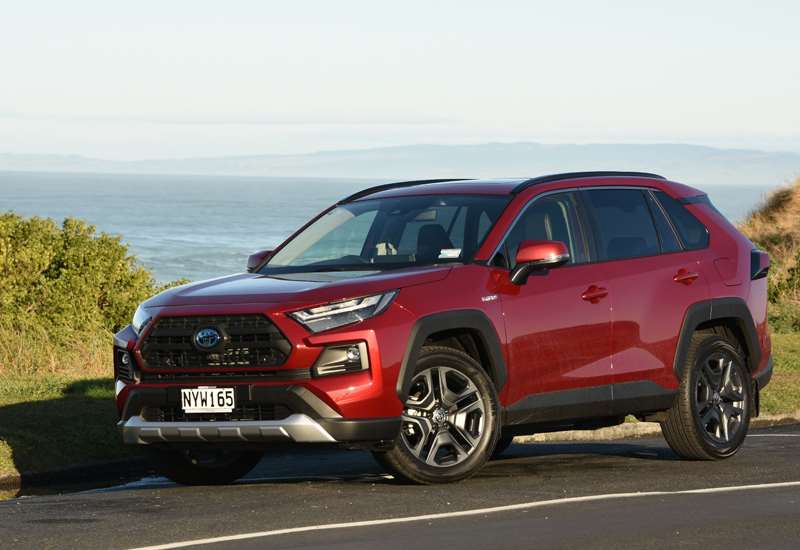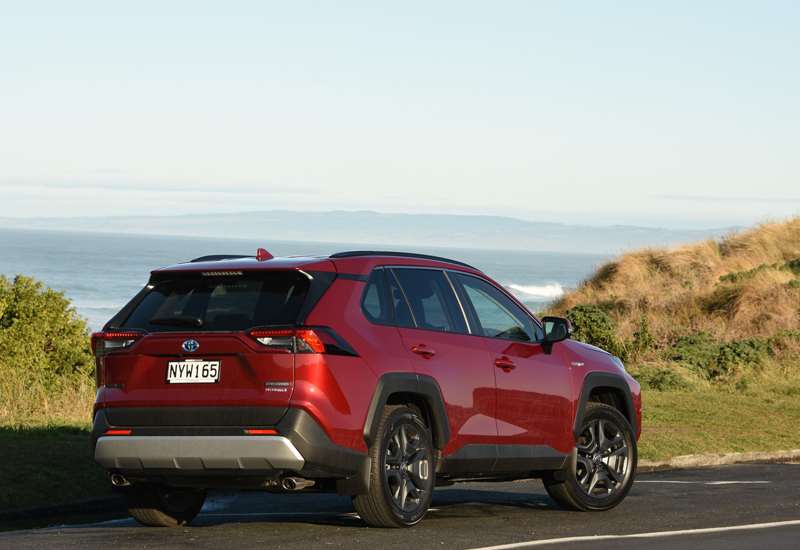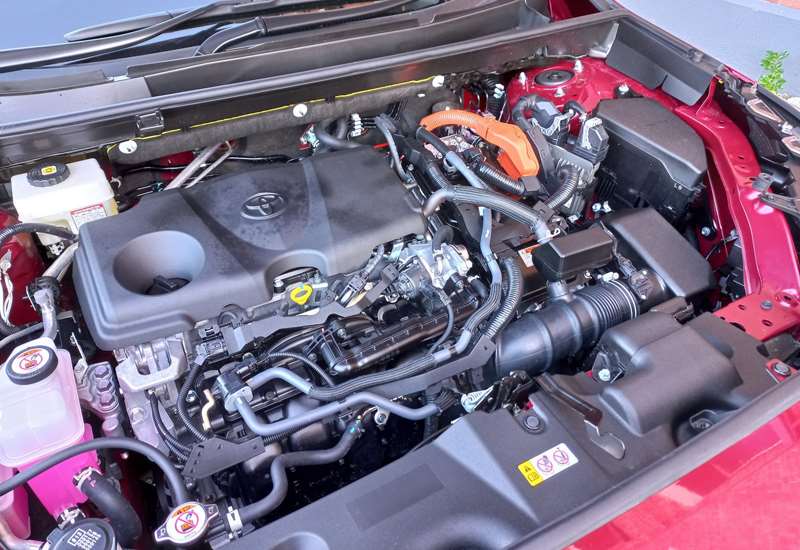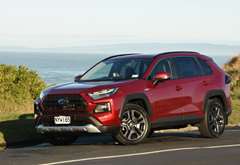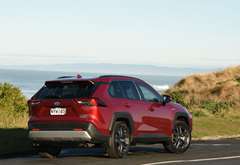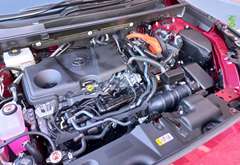Sales success has led Toyota to extend the numbers of variants available within its RAV4 range. David Thomson has been checking out the new offerings.
What’s new?
When Toyota launched the current fifth generation RAV4 in 2019, diesel was dropped from the line-up and the focus turned exclusively to pure-petrol and hybrid options. The latter has proved a runaway success, accounting for more than 60% of RAV4 sales since 2019, and 75% of last year’s tally.
Despite long wait times for delivery, the RAV4 remains hugely popular. It was the country’s top-selling new car last month and ranks second only to the Mitsubishi Outlander for sales year-to-date. Once again, the hybrid RAV4 has been leading the way.
Included in the hybrid sales mix these days are two new variants, the XSE — a specification level that is unique to the hybrid — and the Adventure, a grade previously available only in the pure-petrol range. Both aim to give a sportier air to the hybrid section of the RAV4 range.
The essentials of the RAV4 hybrid remain unchanged with these new additions: all-wheel-drive is the only hybrid option, with power coming from the combination of a 131kW/221Nm 2.5-litre petrol engine and an electric motor and nickel-metal-hydride battery system. Peak power with both the petrol and electric motors doing their stuff is 163kW.
The way in which standard cycle fuel consumption must be assessed has been toughened with the advent of the Clean Car Discount Scheme, and so the RAV4 hybrid’s official figure is now 5.3l/100km (it was previously 4.8l/100km). Still, with C02 emissions of 121g/km, the RAV4 hybrid qualifies for a $2387.24 rebate under the discount scheme.
RAV4 Hybrid pricing, before the rebate, opens at $46,990 for the GX with the GXL at $49,990 and Limited at $57,990. The new XSE slots in between the GXL and Limited with a $53,990 tag, while the Adventure matches the Limited’s tag in standard guise, and costs $58,990 with the two-tone paint option. Pure petrol pricing, by comparison, runs from $38,990 for the GX front-drive to $52,990 for the Adventure.
Whichever way you opt to head, patience is going to be a virtue: Toyota is quoting early-2023 delivery for petrol RAV4s, with the wait for hybrids now stretching to the middle of next year.
Drivesouth was able to the skip the queues for road test purposes, spending time behind the wheel of both the XSE and Adventure hybrid versions.
What comes as standard?
The GLX, which is the step below the XSE in the hybrid range, includes keyless entry and push-button start, dual-zone climate, wireless phone charging, satellite navigation, an 8-inch centre-mounted touchscreen, and smartphone mirroring. The XSE adds a power-operated tailgate, a 7’’ colour multi-information display, synthetic leather trim with blue contrast stitching and heated front sports seats, the driver’s with full power adjustment.
The Adventure, meantime, sticks close to the Limited’s equipment list, adding chilled as well as heated front seats, a sunroof, a 360-degree camera and a premium 9-speaker JBL sound system.
The standard safety suite on all variants includes active radar cruise control, lane tracing assistance, blind spot monitoring, rear cross-traffic alert, pre-collision autonomous braking (with pedestrian and cyclist detection), road sign recognition, auto-dipping headlights, a reversing camera, and front and rear parking sensors.
What’s it like to look at?
Both new variants add sporting accents to the angular and heavily creased look of the current RAV4. While elements of the styling such as the high bonnet line make it look larger than its fourth-generation predecessor, the current RAV4 is shorter, lower, and only slightly wider.
The XSE features a two-tone exterior paint finish, which in essence means a black roof and pillars above one of four primary colour choices (Crystal Pearl, Silver Sky, Graphite, Arctic Dawn blue) for the rest of the car. Gloss black finishes to the grille, lower bumpers, 18-inch alloy wheels, wheel arch mouldings and mirror covers coordinate with the dark roof and pillars.
There is also a two-tone option on the Adventure. Sitting on 235/55 rubber and 19-inch alloys rather than 225/60 tyres and 18-inch alloys, the Adventure is distinguished by its quite different front bumper and grille, and plastic faux scuff plates front and rear.
What’s it like inside?
The cabin is spacious all-round.
Accessed via a power-operated tailgate on both variants tested, the boot has a 542-litre capacity on the XSE, and an even better 580-litre capacity on the Adventure; the difference is due to the latter version being fitted with a space-saver spare wheel, which enables the boot floor to be lowered.
The rear seats adjust for back angle, delivering decent leg and shoulder room and good visibility. Cup holders are incorporated in the flip-down centre armrest. The outboard rear seats have ISOFIX child seats anchors, and dual USB plug points.
There is a typical SUV command-style driving position, with excellent visibility forward and to the sides, but thick rear pillars impair the rear three-quarter view.
Storage options around the front of the cabin include a centre bin (also housing two USB charge points), twin cup holders on the centre console, and a wireless phone charger tray forward of the gearshift.
The quality feel of the interior trim is universally high across the range, with an abundance of soft-touch surfaces on all variants. The XSE and Adventure add their own distinctive flourishes.
Black uppers, black synthetic leather upholstery with blue contrast stitching, and burnished metal trim inserts on the dash, doors and centre console are the XSE’s point of difference. Together they bring an understated elegance to the interior.
The Adventure also has a black interior trim option, but the test car was altogether bolder in its trimming, with grey upholstery, light uppers, and orange contrast stitching and orange trim inserts.
Apple CarPlay and Android Auto were added to the fifth generation RAV4 some months after its 2019 launch, and so this test was my first experience of smartphone mirroring in the vehicle. Using Android Auto to pair my Samsung device, the setup was straightforward, and operation fuss-free.
What’s it like to drive?
The driving attributes of the latest RAV4 hybrid have been explored in Drivesouth previously, and there is little new to add this time round.
The petrol-electric powertrain and its ability to cover short distances on battery power alone play a key role in providing excellent refinement off the mark and during gentle slower-speed motoring. Combine this feature with light steering and a surprisingly nimble chassis, and both variants tested were smooth and easy to drive around town.
Highway motoring is similarly refined and straightforward, with minimal mechanical or wind noise, and reasonably well contained tyre roar. Ride quality is very good too, and there is little need to venture beyond normal drive mode, even when overtaking.
More enthusiastic tarmac driving is something the RAV4 hybrid tolerates with good grace rather than finesse. Steering accurately through bends, it is sure-footed and forgiving, but runs short of pep at higher throttle loads, and lacks a great deal of steering feel.
The various drive modes are selected via a rotary control knob and buttons beside the gear lever. As well as eco, normal, sport, and the short-hop pure EV mode, there is a special ‘‘trail’’ mode that uses selective braking and variable torque delivery to maximise traction.
Real-world fuel economy on test was 6.2l/100km for the XSE and 6.6l/100km for the Adventure; not quite there with the 5.3l/100km standard cycle figure, but about a third better than I would expect from a same-sized pure-petrol SUV.
Verdict
In enhancing the hybrid range with two new variants, Toyota is both responding to strong demand for the petrol-electric RAV4 line, and boosting that demand too. Whatever variant one chooses, the RAV4 hybrid is a strong all-rounder, its appeal dulled only by those long wait-times for delivery.
- David Thomson
